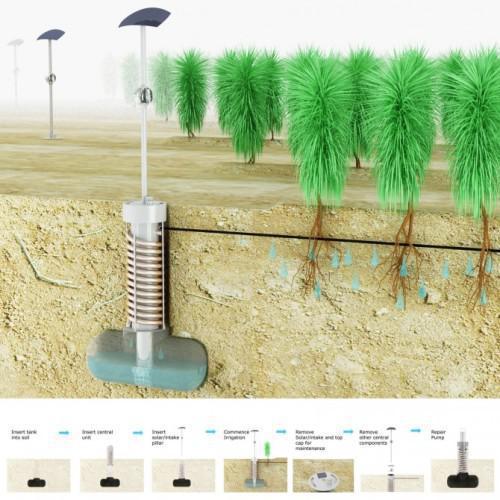«AirDrop»

Статья о технологии в "Технике молодежи"
Water from thin air: Aussie Ed's Airdrop an international hit
Содержание
Растущее население требует все новых территорий под ведение сельского хозяйства. Далеко не вся поверхность планеты пригодна для этого.
Что могут предложить современные технологии?
Технология получила название «Воздушный сад»: комплекс из 10 осушителей, размещенных на рекламном щите, подает воду в систему капельного орошения. Всего за одну неделю работы с помощью полученной из воздуха воды было выращено 2448 кочанов свежего салата, избавленного от загрязнения. Комплекс фильтров эффективно очищает воду, так что при необходимости ее можно смело использовать не только для полива, но и в качестве питьевой воды
Fogs have the potential to provide an alternative source of fresh water in dry regions and can be harvested through the use of simple and low-cost collection systems. Captured water can then be used for agricultural irrigation and domestic use. Research suggests that fog collectors work best in locations with frequent fog periods, such as coastal areas where water can be harvested as fog moves inland driven by the wind. However, the technology could also potentially supply water in mountainous areas if the water is present in stratocumulus clouds, at altitudes of approximately 400 m to 1,200 m (UNEP, 1997b). According to the International Development Research Centre (1995), in addition to Chile, Peru, and Ecuador, the areas with the most potential to benefit include the Atlantic coast of southern Africa (Angola, Namibia), South Africa, Cape Verde, China, Eastern Yemen, Oman, Mexico, Kenya, and Sri Lanka.
|
|
Researchers at MIT's School of Engineering, working with colleagues at the Pontificial University of Chile in Santiago, are harvesting potable water from the coastal fog that forms on the edge of one of the driest regions on earth. Using a simple system of suspended mesh structures, placed on hilltops in areas with persistent fog and prevailing westerly winds, local Chilean communities collect fog water for drinking and agricultural use. Fog collecting technology is still in its infancy but laboratory experiments have shown that variations in the mesh spacing as well as the size and the wettability of the fibers in the mesh all affect the volume of water that can be collected each day. Through engineering analysis and optimization of the mesh geometry and its surface chemistry the team has been able to increase the fog collecting efficiency of existing designs by 500%. The technology holds great promise as a locally deployable and scalable alternative to other energy-intensive desalination technologies. Mesh-based Fog Harvesters are passive, inexpensive to fabricate, with close to zero operating costs, and can be deployed in similar environments throughout the world.
EcoloBlue's new 400,000 Liter/Day Atmospheric Water Generator Station will be the first of it's kind in the world. We present the 3D design video of the project. Not only can EcoloBlue's atmospheric water generators be used individually for smaller water needs, these water stations are intended for areas where the need for water is greater. Please contact us if you wish to discuss a possible project.
The Warka’s water harvesting technique and construction system are inspired by several sources. Many plants and animals have developed unique micro- and nano-scale structural features on their surfaces that enable them to collect water from the air and survive in hostile environments. By studying the Namib beetle’s shell, lotus flower leaves, spider web threads and the integrated fog collection system in cactus, we are identifying specific materials and coatings that can enhance dew condensation and water flow and storage capabilities of the mesh. The termite hives have influenced the design of Warka’s outer shell, its airflow, shape and geometry. We also looked at local cultures and vernacular architecture, incorporating traditional Ethiopian basket-weaving techniques in Warka’s design.
Молодой изобретатель из Мельбурна Эдвард Линакре получил премию Джеймса Дайсона в конкурсе молодых изобретателей во всем мире за идею «AirDrop» — десантную концепцию системы орошения, другими словами — Эдвард придумал простой способ получать воду из воздуха!
«AirDrop»
Статья о технологии в "Технике молодежи"
Water from thin air: Aussie Ed's Airdrop an international hit
Аллан Савори: Как озеленить пустыню и повернуть вспять изменение климата
Green revolution in deserts of Israel
О методе
Американские ученые из Калифорнийского университета в Беркли и Массачусетского технологического института создали прибор, с помощью которого можно превращать воздух в воду.
Содержание